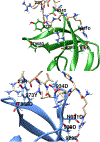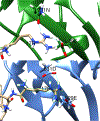Engineering human JMJD2A tudor domains for an improved understanding of histone peptide recognition
- PMID: 35927178
- PMCID: PMC9771871
- DOI: 10.1002/prot.26408
Engineering human JMJD2A tudor domains for an improved understanding of histone peptide recognition
Abstract
JMJD2A is a histone lysine demethylase which recognizes and demethylates H3K9me3 and H3K36me3 residues and is overexpressed in various cancers. It utilizes a tandem tudor domain to facilitate its own recruitment to histone sites, recognizing various di- and tri-methyl lysine residues with moderate affinity. In this study, we successfully engineered the tudor domain of JMJD2A to specifically bind to H4K20me3 with a 20-fold increase of affinity and improved selectivity. To reveal the molecular basis, we performed molecular dynamics and free energy decomposition analysis on the human JMJD2A tandem tudor domains bound to H4K20me2, H4K20me3, and H3K23me3 peptides to uncover the residues and conformational changes important for the enhanced binding affinity and selectivity toward H4K20me2/3. These analyses revealed new insights into understanding chromatin reader domains recognizing histone modifications and improving binding affinity and selectivity of these domains. Furthermore, we showed that the tight binding of JMJD2A to H4K20me2/3 is not sufficient to improve the efficiency of CRISPR-CAS9 mediated homology directed repair (HDR), suggesting a complicated relationship between JMJD2A and the DNA damage response beyond binding affinity toward the H4K20me2/3 mark.
Keywords: CRISPR; JMJD2A; epigenetics; histone; molecular dynamics.
© 2022 Wiley Periodicals LLC.
Conflict of interest statement
CONFLICTS OF INTEREST
The authors have no conflicts of interest to report.
Figures








Similar articles
-
Molecular recognition of H3/H4 histone tails by the tudor domains of JMJD2A: a comparative molecular dynamics simulations study.PLoS One. 2011 Mar 25;6(3):e14765. doi: 10.1371/journal.pone.0014765. PLoS One. 2011. PMID: 21464980 Free PMC article.
-
Tudor domain of histone demethylase KDM4B is a reader of H4K20me3.Acta Biochim Biophys Sin (Shanghai). 2020 Aug 5;52(8):901-906. doi: 10.1093/abbs/gmaa064. Acta Biochim Biophys Sin (Shanghai). 2020. PMID: 32537648
-
Recognition of histone H3 lysine-4 methylation by the double tudor domain of JMJD2A.Science. 2006 May 5;312(5774):748-51. doi: 10.1126/science.1125162. Epub 2006 Apr 6. Science. 2006. PMID: 16601153
-
Tudor: a versatile family of histone methylation 'readers'.Trends Biochem Sci. 2013 Nov;38(11):546-55. doi: 10.1016/j.tibs.2013.08.002. Epub 2013 Sep 10. Trends Biochem Sci. 2013. PMID: 24035451 Free PMC article. Review.
-
KDM4/JMJD2 histone demethylases: epigenetic regulators in cancer cells.Cancer Res. 2013 May 15;73(10):2936-42. doi: 10.1158/0008-5472.CAN-12-4300. Epub 2013 May 3. Cancer Res. 2013. PMID: 23644528 Free PMC article. Review.
Cited by
-
Targeting Tudor domains in leukemia: epigenetic insights for drug development.Epigenomics. 2025 Aug;17(12):817-825. doi: 10.1080/17501911.2025.2525746. Epub 2025 Jul 7. Epigenomics. 2025. PMID: 40622840 Review.
References
Publication types
MeSH terms
Substances
Grants and funding
LinkOut - more resources
Full Text Sources
Research Materials

